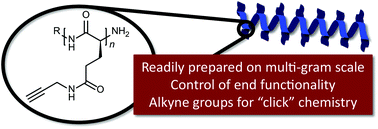Hydrolysis resistant functional polypeptide scaffold for biomaterials†
Abstract
For biomaterials, rich functionality often comes at a cost of precise control over structure. In this paper, we have developed a hydrolysis resistant polypeptide that marries the potential for expansive modification with synthetic control. This polymer, poly(γ-propargyl-L-glutamine) may be prepared from commercially available or previously synthesized poly(L-glutamate) by routine amide bond coupling reactions on a multi gram scale. Afterwards, the polymer may be altered to suit many applications through modification of the side chains or end group by orthogonal and quantitative reactions. The ease of synthesis and versatile nature of poly(γ-propargyl-L-glutamine) makes it a unique and ideal scaffold for biomaterial applications.



 Please wait while we load your content...
Please wait while we load your content...